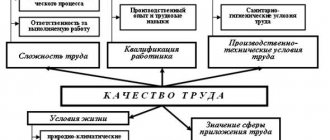The issue of employee motivation has existed from the very beginning of the development of capitalist relations. And each time, academic economists, adapting to the requirements of society and the existing situation, found various methods of motivating staff.
In our country, long-outdated rules for calculating wages and bonuses apply everywhere. New positions and specialties have appeared, and the question of giving them decent pay arises very often.
In this regard, more and more attention is beginning to be paid to a new system called grading .
Grading is a method of motivating personnel, which is based on assessing the employee in terms of the value of his position for the enterprise. Based on the data obtained through analysis, wages are calculated, which takes into account many aspects, ranging from the strong-willed qualities of the employee himself to his direct contributions to the development of the company.
The grading system is the process of ranking all positions in terms of their importance to the company. In this way, not a vertical hierarchical structure is formed, but a horizontal one, in which a simple welder can receive a salary higher than his master. Within one position you can improve your qualifications, grow and get more pay.
The grading system is a completely new approach that has already appealed to many modern companies seeking to maintain a competitive position in the market.
The essence of the system
The employee's salary is established by the employment contract in accordance with the current remuneration system in this organization in accordance with labor legislation. The most common are piecework, time-based and tariff systems. At the same time, the employer tries to find a salary calculation option that most accurately meets the specifics of its activities and allows for a better assessment of the contribution of each employee in achieving common goals. One such method is the grading system.
So what is a position grade in the remuneration system? The term comes from the English word grade - class, category, degree. Grading (from the English grading) - classification, sorting, ordering. Grading is the ranking of positions, their hierarchical positioning in accordance with the value of the position for the enterprise. This gives the position an advantage not just in terms of vertical subordination or complexity of work, but also depending on its importance for the goals of the organization.
Despite the fact that, according to Art. 22 of the Labor Code of the Russian Federation, the employer is obliged to provide employees with equal pay for work of equal value; Article 132 of the Labor Code of the Russian Federation states that the salary of each employee depends on his qualifications, the complexity of the work performed, the quantity and quality of labor expended. This allows you to use salary grades based on the employee’s business qualities, both personal and professional qualifications.
Unlike the tariff system, with the grading system the size of the salary is influenced not only by education, experience and skills, but also by other criteria important for the organization and position: controllability standards, the volume of communications, the level of responsibility and independence, the cost of an error, and others. Moreover, the factors are universal for assessing all positions; all company personnel are assessed according to one set of criteria.
Stages of implementation of personnel grading
- Appointment of a working commission, choice of methodology.
- Collection of information about company employees.
- Analysis of the information received. Studying positions to determine a universal set of factors suitable for each employee. According to Art. 22 of the Labor Code of the Russian Federation, the level of remuneration is influenced by:
- experience;
- education;
- profession and specialty.
Each employer has the right to independently choose factors that are significant for the company.
- Development of a salary system after the following activities:
- distribution of identified factors by levels;
- determination of the average salary in the labor market for similar positions;
- calculation of the number of levels;
- determination of the maximum and minimum salary for each grade.
- Documentation of the grader system developed based on the work performed. Familiarization of company employees with the new rules of remuneration against signature.
- Analysis of the introduced system to identify errors and shortcomings.
When to use
The grading system is suitable for large and medium-sized enterprises. The costs of introducing the method and large-scale preparatory work are high, and in companies with a small staff they are not justified. In addition, the main advantage of the grade system is that in companies with a large number of employees, it allows you to clearly optimize the structure, get rid of such hierarchical positions as “senior”, “junior” and the like, i.e. it will allow you not to inflate the staff. And it gives employees the opportunity to build a career not vertically, but horizontally within the confines of their position. In Russia, grades are used in Rosneft, Sberbank, Lukoil, Rosatom and other major organizations.
Advantages and disadvantages
Much earlier than in Russia, the grading system began to be used and has proven itself well in the USA and Europe. Therefore, the experience accumulated there, assessments and reviews of remuneration by grade allow us to highlight both the advantages and disadvantages of the system.
Advantages
Pros of introduction:
- clear organization of the company structure (ranking of positions by grade depending on the importance of the position for the overall strategy);
- dependence of salary on work efficiency;
- establishing the objective value of each employee for the company;
- the opportunity to build a career and increase your salary horizontally while increasing your grade without changing your position;
- transparency (it is clear why the employee’s remuneration is higher or lower than others, he understands his professional prospects);
- motivation (the employee is interested in increasing the efficiency of his work and moving to a higher grade).
A well-structured grading system acts as part of a personnel development strategy.
Flaws
In addition to tangible advantages, the grading remuneration system also has disadvantages, for example:
- complexity of implementation (requires large-scale preliminary and supporting work);
- high costs (in order to avoid subjectivity when setting payment levels in grades and due to the general labor intensity of system development, it is advisable to use the services of third-party specialists, which entails additional costs);
- difficulty in forming a loyal attitude of staff to the new form of salary calculation (there is a danger that it will become a demotivating circumstance if employees negatively perceive the assessment of their business qualities);
- novelty (employees who misunderstand the essence of the new system, especially if, based on the results of the assessment, the amount of remuneration for their grade will decrease, they can file a complaint with the regulatory authorities about discrimination).
Tariffs or grade?
At some points the system bears a noticeable resemblance to the tariff system. After all, they are both built on a hierarchical grading of positions within one organization. The difference is that tariffs are set based on the complexity of the job task performed by employees. And grades are a more common system. Here, to assign a salary, a whole range of factors are taken into account - the qualifications of the worker, the responsibility of the job, mistakes made, etc.
The grader system promotes career building not only through promotion, but also within one’s grade. To get a salary increase, you don't have to wait for a promotion. All you need is a higher grade. When receiving it, even lower-level employees can receive more salary than their managers.
This is another significant difference between the grader approach and the tariff approach. With the latter, positions are lined up in a strict vertical order. You can achieve an increased salary only by moving up the career ladder.
What is the difference between the tariff system and grades?
- The amount of remuneration depends on professional skills, knowledge and work experience. The grade system applies broader criteria for assessing an employee’s performance.
- The hierarchical structure of positions is incremental, while grading allows an employee to increase their salary level without building a vertical career.
- Salary calculation according to the tariff schedule is based on the minimum salary multiplied by various coefficients. In the grading system, calculations are made based on the weight of the position, which is calculated in points.
- Strict hierarchy of positions in the tariff system. Grading determines an employee's place depending on his usefulness to the company.
Calculation method and example
In Russia, a system of grades in remuneration with a simplified point-factor calculation option has become widespread. Implementation of such a method requires the following steps:
- Compiling a list of factors important for each position. They are ranked taking into account the characteristics of job functions, organizational strategy and other practical issues. The qualifications guide will help highlight the business characteristics for the position. It specifies education, experience, possession of the necessary knowledge, skills and other requirements. In addition, the determining factors include the complexity and volume of work, the level of responsibility, the level of production risk, etc.
- Estimation of the weight of each factor.
- Calculation of the minimum and maximum points for a position, taking into account the identified factors.
- Dividing the range of scores into several equal segments corresponding to a specific grade.
- Establishing minimum and maximum salary values for each position.
- Determining the amount of payment. For example, the first grade, with a minimum value of factors, receives the average market salary for the position; for each subsequent level it increases by a certain percentage or amount. As a result, a table of grades is compiled.
A simplified example of calculating the salaries of a financial director and a cashier will help you visualize what a grade is in the remuneration system.
Let's highlight the determining factors for all positions and divide them into levels, assigning each a certain number of points (Table 1):
Table 1.
| Criteria (factors) | 1 point | 5 points | 10 points |
| Knowledge | Primary vocational education | Secondary vocational education | Higher education and specialized knowledge |
| Experience | Up to 1 year | 1-5 years | From 5 years |
| Responsibility | Only for your own actions | For completing tactical tasks | For completing strategic tasks |
| Working conditions | Favorable | Minor compensable health risk | Hazardous working conditions |
The values of each level must be clear, without the possibility of subjective assessment.
Using the qualification directory of positions for managers, specialists and other employees, we determine the range of points for each position (Table 2):
Table 2.
| Criteria | Cashier | Financial Director |
| Knowledge | 5 | 10 |
| Experience | 1-10 | 5-10 |
| Responsibility | 1-5 | 5-10 |
| Working conditions | 1 | 1 |
| Total points | 8-21 | 21-31 |
The decision about how many grades there are in an organization is made depending on the accuracy with which the assessment is carried out. In our conditional example, we will accept the following grades:
- 1-7 points - 1 grade;
- 8-14 points - 2nd grade;
- 15-21 points - 3rd grade;
- 22-28 points - grade 4;
- 29-35 points - 5th grade.
Depending on business qualities and the importance of the tasks performed, the cashier belongs to grade 2, 3 or 4, the financial director - to grade 3, 4 or 5. Other positions of comparable importance will overlap in grade with these positions.
Thus, the hierarchy not only in terms of vertical subordination, but also in terms of importance for the goals of the organization, contributes to the fact that the salaries of more important positions are higher. For example, in an IT organization, developers constitute a higher grade than administrative and management personnel.
Based on the calculation of average salaries in the region, we will derive the total salary for each grade.
We will set the premium for each subsequent grade at 10% of the previous one. Let's enter the position importance coefficient and calculate the salary for each position (Table 4): Table 4.
| Coefficient | 2nd grade | grade 3 | 4 grade | 5 grade |
| Salary by grade | 25 000 | 27 500 | 30 250 | 33 275 |
| Cashier | 1 | 25 000 | 27 500 | 30 250 |
| Financial Director | 1,5 | 41 250 | 45 375 | 49 912 |
This example of calculating wage grades shows the essence of the system, but is simplified. The original methodology for determining official salaries in the grade system is much more complicated. Calculations are based not only on the point-factor method, but also on mathematical calculations of weight, the coefficient of value of each factor, step, matrices, profile guide tables, and graphs. These procedures are very labor intensive. The implementation of such systems takes a period of 6-12 months and is accompanied by a large amount of paperwork. They are implemented in large corporations with the help of specialized external organizations and consultants.
Factors that matter when establishing grades
According to Art. 132 of the Labor Code of the Russian Federation, a worker’s salary is determined taking into account:
- employee qualifications;
- complexity of work;
- amount of labor spent;
- quality of work.
Subject to the provisions of Art. 22 of the Labor Code of the Russian Federation and clause 10 of the resolution of the Plenum of the Supreme Court No. 2, factors influencing the amount of wages are also:
- work experience in the specialty or position;
- health status;
- the level of education;
- profession and specialty.
The employer independently selects the factors that matter. The selected factors are applied taking into account the characteristics of the employee’s position, the direction of the organization’s activities and other practical issues.
For example, in accordance with the qualification directory of positions approved by Resolution of the Ministry of Labor dated August 21, 1998 No. 37, the director must:
- Get higher professional education.
- Have 5 years of professional experience.
- Possess legal, technological, economic knowledge, information about scientific achievements in the field of activity of the organization.
- Be able to effectively lead an organization.
Qualification requirements for lower-level employees are several times lower. For example, for a seller the main criterion will be the quantity of goods sold, for a cleaner - the cleanliness of the reporting area.
It is impossible to compile a single list of factors with a detailed indication of practical criteria, so usually a general list is taken into account, including evaluation criteria:
- knowledge;
- experience;
- difficulty of work;
- level of responsibility;
- level of production risk, etc.
Documenting
The introduction of a grading system at an enterprise is formalized by the regulations on remuneration. Additionally, a concept or regulation on grades may be drawn up, but such documents are not mandatory. If the organization has a trade union body, it is necessarily involved in the approval of the new form of calculation of remuneration. Based on the local act, changes are made to the collective agreement and employment contracts. The requirements for assigned grades must be reflected in job descriptions.









